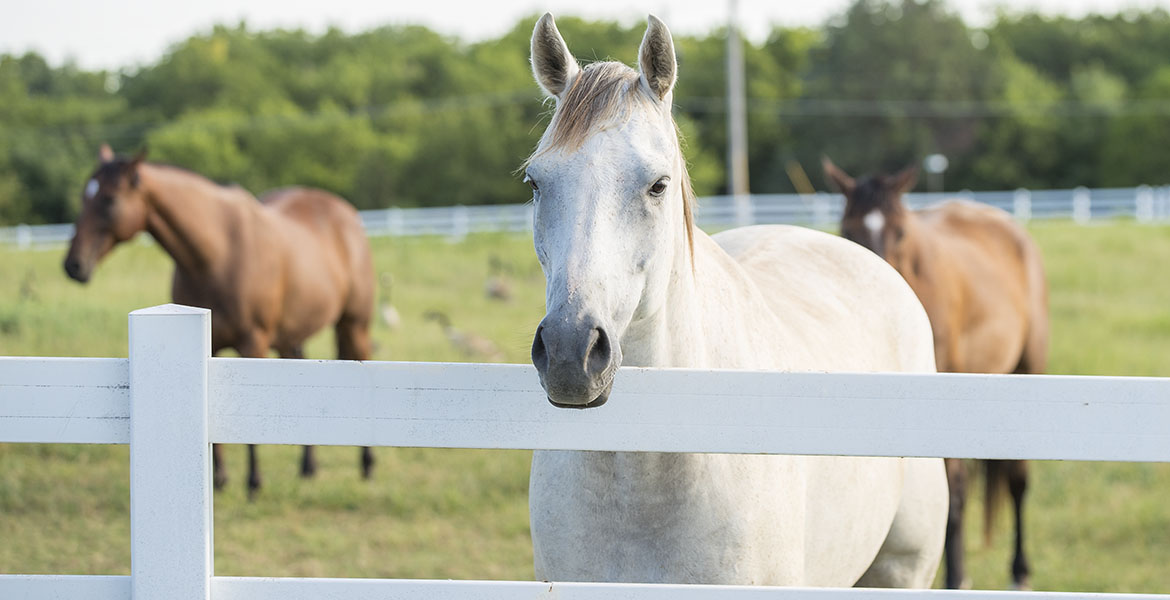
Veterinary Viewpoints: First Aid for Horses
Monday, August 17, 2020
At some point horse owners are likely to face an emergency or injury involving wounds and eye problems. It may be hard to tell if it’s a life-threatening situation, but an equine first-aid kit is a key component to providing ample first aid.
A tool box holds a good portable first-aid kit, allowing you to keep the necessary items in one place, wherever your horse is at a barn or in a travel trailer.
You’ll need to include bandage scissors, gauze pads, two cotton leg wraps, Ace wrap or Vet wrap, one or two rolls of one-inch white medical tape, hoof pick, wound cleanser (betadine scrub), saline solution, hydrogen peroxide, antibiotic wound ointment, a couple of syringes, eye wash, eye ointment, thermometer, hemostats, tweezers, a roll of duct tape, stethoscope (optional) and phone numbers (your local veterinarian and 1-800-get-a-dvm). The latter is a toll-free number developed by the American Association of Equine Practitioners that helps you find a veterinarian in an unfamiliar area, such as when you’re at a horse show.
Call your veterinarian if your horse is in or has any of these conditions:
- A cut with a lot of bleeding.
- Lying down and won’t get up.
- Rolling on the ground a lot.
- Very cloudy eye.
- Keeps an eye closed.
- Won’t put weight on a leg.
- Is very lame or won’t walk.
- Fever greater than 102°F.
- Coughing excessively, choking or has difficulty breathing.
Use these techniques when you first encounter an injury:
Bleeding caused by punctures, lacerations or cuts — An adult horse has nearly 12 gallons of blood circulating in its body and can lose more than two gallons before showing signs of shock. Still, if your horse is bleeding, apply pressure with gauze pads over the area or maintain the pressure with a leg wrap, since most lacerations occur on a leg.
Overheating — In Oklahoma, overheating is a big problem. Most horses overheat because of heat stress and not sweating (anhydrosis). Signs of overheating include flared nostrils, high body temperature, lack of energy (lethargy) and dehydration. A simple test to determine dehydration is to pinch up (tent) a fold of skin on the side of the horse’s neck. If the skin fold takes longer than two seconds to flatten, dehydration is present. Immediately cool horses by spraying a water hose over the entire body, especially the back, inside all legs and underside of the neck (jugular vein area). Move the horse into the shade. As with people, high body temperature can affect the brain.
If the horse’s body temperature is greater than 105°F, place ice packs on top of its head to help reduce the temperature around the brain. Give the horse frequent, small drinks of water. Do not allow the horse to satisfy its thirst all at once because that could cause colic. Allow five to six swallows, then take the water away for a minute. Repeat this process until the horse has quenched its thirst. You can also use a fan to help cool the body temperature faster.
Eye injuries — Treating eye problems early in horses is very important; any delay could result in more expense and possible loss of vision in the eye. Indications of eye problems include constant squinting and/or a red and/or cloudy eye. Flush the eye with an eye wash or plain water. To flush a horse’s eye, gently place the side of your palm directly in front of the eye, take the index finger and thumb and part the eyelids with your index finger and thumb. Apply a gentle stream of eyewash across the top or bottom of the eye, not in the middle.
Colic — Signs of colic include lying down, getting up and down often, frequent rolling, repeated pawing, looking back at the flanks and curling the lip. Call your veterinarian and keep the horse quiet if possible. Walking the horse may result in fatigue, so let the horse lie down. However, if the horse is pawing or wanting to roll, get the horse up and walk, which may take its mind off the pain. Do not give the horse anything to eat or drink. While you wait for your veterinarian to arrive, it is critical to keep the horse from traumatizing itself.
With first aid for your horse, be prepared and have a plan. Many techniques are simple and easy to apply. It is also vital to have a veterinarian examine the horse, no matter how minor an injury may look. Small injuries could spell trouble later.
STORY BY: Daniel J. Burba, DVM, Dipl. ACVS, is a professor of equine surgery at Oklahoma State University’s College of Veterinary Medicine. He is a diplomate of the American College of Veterinary Surgeons and head of the Department of Veterinary Clinical Sciences at the college’s Veterinary Medical Hospital.
